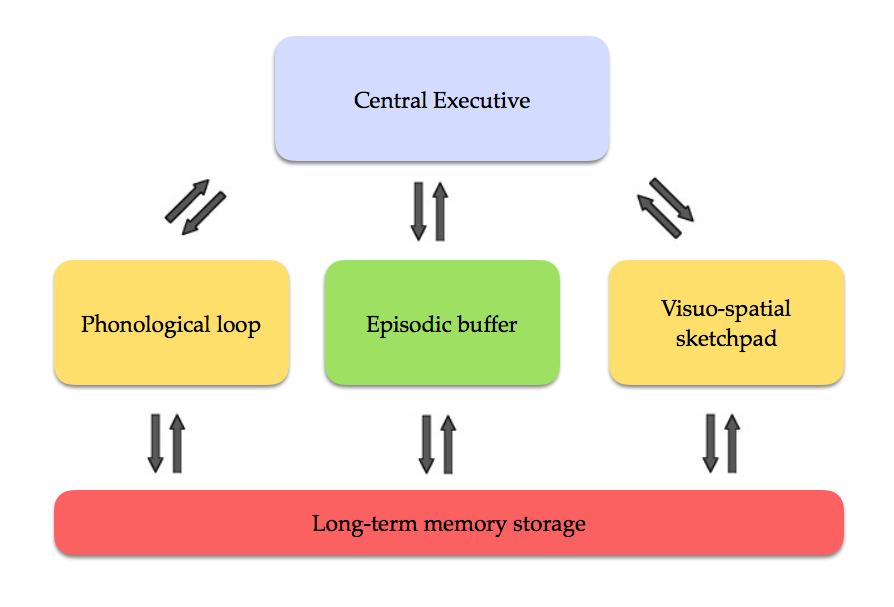Working memory model
 The working memory model can be seen as a development of the multi-store model of memory. What is called short-term memory in the original model is changed to a more sophisticated version in the working memory model. This is an example of how theories and models develop over time as science produces new findings.
The working memory model can be seen as a development of the multi-store model of memory. What is called short-term memory in the original model is changed to a more sophisticated version in the working memory model. This is an example of how theories and models develop over time as science produces new findings.
Baddeley and Hitch (1974) were among the first to challenge the view that STM is a single store. Their working memory model suggests that STM is not a single store but rather consists of a number of different stores. Baddeley and Hitch observed in lab experiments that if participants perform two tasks simultaneously that both involve listening, they perform them less well than if they did them separately. They had also noticed that if participants performed two tasks simultaneously that involved listening and vision, there was no problem. The procedure where participants carry out two tasks at once is known as a dual-task technique.
This suggests that there are different stores for visual and auditory processing. Baddeley and Hitch suggested that working memory should be seen as a kind of mental workspace, which provides a temporary platform that holds relevant information for use in any cognitive task. Once the task is completed, the information can quickly disappear and make space for a new round of information processing. Baddeley and Hitch have continued to work on the model since it was devised in 1974 and they have added new features to the model in response to criticism and new findings.
ATL: Inquiry: Can we multi-task?

We wouldn't be able to function as human beings if we couldn't "multi-task." Can you imagine if we couldn't talk to someone while driving a car? If we couldn't read a sign while walking down the street? Or if we couldn't play a video game without listening to our favourite tunes?
The Working Memory Model argues that as long as we are using different short-term memory stores, then there should not be a problem with multi-tasking. However, when we try to do two things at once which require the same STM store, then we run into problems.
In order to test this, carry out one of Baddeley & Hitch's early dual-task techniques. Get together a group of friends and randomly allocate them into two groups. Have one group read a story of your choice. It should be 300 - 500 words in length. Give them three minutes to read the story. At the end of the three minutes, ask them six to ten questions to test their understanding of the story.
Now do the same with the other half of the group. But this time, ask them to recite a phone number while reading the text. After three minutes, give them the same six to ten questions to test their understanding of the story.
Compare the results. Is there a significant difference in the data? What does this tell us about our ability to multi-task?

The Working Memory Model is a hypothetical model of STM that includes several components in contrast to the Multi-Store Model's version of STM as one big store. Now we will look at each of the hypothesized components of working memory.
The central executive
The central executive is an attention control system that monitors and coordinates the operations of the sub-systems of processing and storage. The central executive is the most important part of the model because it is seen as a kind of CEO of the memory system, that is, it decides how and when the sub-systems are used. The central executive has the capacity to focus attention, to divide attention between two or more sources, and switch attention from one task to another. The central executive has limited capacity, which basically means that you cannot attend to a lot of things at the same time. It is also modality-free, which means that it can process any sensory information, whether it be auditory or visual.
Baddeley suggests that the most important job of the central executive is attention control. This happens in two ways.
- The automatic level is based on habits that rely on schemas in long-term memory and are controlled more or less automatically by stimuli from the environment. This includes routine actions such as cycling to school and places only limited demand on attention.
- The supervisory attention level deals with planning and decision-making. It creates new strategies when the old ones are no longer sufficient. It is also active in emergency situations - for example, when a car is suddenly coming at you when you are cycling. The system is also involved in situations that require self-regulation such as trying to avoid eating that lovely chocolate dessert when you are trying to eat a more healthy diet. The supervisory attention system is capable of considering alternative plans of action and choosing the most favourable.
People rely a great deal on automatic processing in their daily lives. Think about a situation in which you suddenly find yourself outside your front door, but you cannot really remember how you got there because you were talking to somebody on your mobile phone. You probably also know that if something had happened on the way - such as another person talking on a mobile bumping into you - you would become attentive to make a quick evaluation of the situation.
The phonological loop (verbal STM)
The phonological loop is the auditory component of STM and it is divided into two components. The first component is the articulatory control system, or inner voice, which can hold information in a verbal form. This happens when you try to remember a telephone number and repeat it to yourself. The articulatory loop is also believed to hold words ready for cognitive tasks, for example as you prepare to speak. The second component is the phonological store or inner ear. It holds auditory memory traces. Research shows that a memory trace can only last from 1.5 to 2 seconds if it is not rehearsed by the articulatory control system. The phonological store can receive information directly from sensory memory in the form of auditory material, from LTM in the form of verbal information, and from the articulatory control system. The phonological loop has significant implications for a wide range of everyday activities. Actually, any activity that requires retention of a verbal sequence such as remembering a new telephone number long enough to dial it, repeating a foreign word, or counting objects would rely on the phonological loop.
Research using articulatory suppression lends support to the working memory model. Articulatory suppression means that participants are asked to repeat a word such as 'the' or a number such as 'one' while they memorize a list of words. Such studies show that concurrent tasks decrease the accuracy of recall of the information because the phonological rehearsal system is overloaded. The same would happen if you were asked to read prose and at the same time repeat a word or a number as described above because both tasks depend on the phonological loop.
Research in psychology: Landry and Bartling (2011)
 Landry and Bartling (2011) conducted an experiment using articulatory suppression to test the Working Memory Model. The aim was to investigate if articulatory suppression would influence recall of a written list of phonologically dissimilar letters in serial recall. The experiment used independent designs with two groups: a control group that performed no concurrent task while memorizing a list and an experimental group, which performed the concurrent task of articulatory suppression while memorizing a list. The participants were randomly assigned to one of the two conditions. The hypothesis was that the accuracy of serial recall would be higher in the control group compared to the experimental group. The participants consisted of thirty-four undergraduate psychology students.
Landry and Bartling (2011) conducted an experiment using articulatory suppression to test the Working Memory Model. The aim was to investigate if articulatory suppression would influence recall of a written list of phonologically dissimilar letters in serial recall. The experiment used independent designs with two groups: a control group that performed no concurrent task while memorizing a list and an experimental group, which performed the concurrent task of articulatory suppression while memorizing a list. The participants were randomly assigned to one of the two conditions. The hypothesis was that the accuracy of serial recall would be higher in the control group compared to the experimental group. The participants consisted of thirty-four undergraduate psychology students.
Procedure
The participants were tested individually. In the experimental group, participants first saw a list of letters that they had to recall while saying the numbers '1' and '2' at a rate of two numbers per second (the articulatory suppression task). The control group saw the list of letters but did not engage in an articulatory suppression task.
There were ten lists each consisting of a series of 7 letters randomly constructed from the letters F, K, L, M, R, X, and Q. These letters were chosen because they don't sound similar. The experimenter presented one letter series at a time. The participants received an answer sheet with seven blanks in each row. Before the experiment started, each participant viewed one practice list in order to become acquainted with the procedure.
In the control group, the experimenter showed participants a printed list for five seconds, instructed them to wait for another five seconds, and then instructed them to write the correct order of the letters on the answer sheet as accurately as possible. This was repeated ten times. In the experimental group, participants received instructions to repeatedly say the numbers '1' and '2' at a rate of two numbers per second from the time of presentation of the list until the time they filled the answer sheet. This was also repeated ten times. Each trial was scored for accuracy of recall. The trial was scored as correct if the letters were in the correct position. The experimenter then calculated the average percent correct recall for both groups.
Results
The results showed that the scores from the experimental group were much lower than the scores from the control group. The mean percent of accurate recall in the control group was 76% compared to a mean of 45% in the experimental group. Although the difference in the means was large, the standard deviations were nearly identical with SD = 0.13 for the control group and SD = 0.14 for the experimental group. A T-test was calculated and found a significant difference of p < 0.01.
The results supported the experimental hypothesis as the mean percent of accurate recall in the control group was higher than the mean percent of accurate recall in the experimental group and the t-test showed that the results are significant at p < 0.01. The data seems to support the prediction of the Working Memory Model that disruption of the phonological loop through the use of articulatory suppression results in less accurate working memory. In line with the model's prediction, articulatory suppression is preventing rehearsal in the phonological loop because of overload. This resulted in difficulty in memorizing the letter strings for participants in the experimental conditions whereas the participants in the control condition did not experience such overload. This experiment is asking participants to remember strings of random letters in order to test a specific part of the working memory and it can be argued that although this does not resemble a task that you would do in your everyday life. However, it could resemble what is happening during multi-tasking - for example, when you are trying to study for a psychology test while at the same time talking to a friend on the phone,
The visuospatial sketchpad
The visuospatial sketchpad is the visual component of STM and could be called the inner eye. It is a temporary store for visual and spatial information from either sensory memory or LTM. Visual processing includes the storage and manipulation of visual patterns and spatial movements in two or three dimensions. The visuospatial sketchpad helps us remember not only what visual information is important, but also where it is. This is important when we have to find our way around the house and in visual imagery, for example, when trying to remember where we left our mobile phone.
The episodic buffer
If all this information is being processed in separate short-term memory stores, how are we actually able to understand what is happening in the world around us? For this, Baddeley proposed the episodic buffer. This buffer temporarily holds several sources of information active at the same time, while you consider what is needed in the present situation. This means - auditory and visual information together, as well as information from LTM. Imagine yourself consciously trying to recall the details of a landscape or the sound of your favourite band while you are telling somebody else about it. According to Baddeley, they will appear via the episodic buffer. The role of the buffer is to act as a temporary and passive display store until the information is needed - much like a television screen - but it has limited capacity. Baddeley argues that the episodic buffer is responsible for our conscious awareness.
Research in psychology: Case studies of brain damage and WMM
 The cognitive approach carries out many lab experiments to support their models. For example, the study by Landry and Bartling (2011) that is described above. But often they turn to neuroscience to get biological support for their theories.
The cognitive approach carries out many lab experiments to support their models. For example, the study by Landry and Bartling (2011) that is described above. But often they turn to neuroscience to get biological support for their theories.
Warrington and Shallice (1970) carried out a series of tests on patient KF, who had suffered brain damage as a result of a motorcycle accident. KF's LTM was intact, but he showed impairment of his short-term memory.
This sounds like the case of HM, but it is very different. Even though he appeared to have problems recalling lists of words and numbers - something that is referred to as his "memory span" - he was able to learn. He was clearly moving information from STM to LTM, but how was this possible?
Over the course of the case study, Warrington and Shallice (1972) found that although he quickly forgot numbers and words when they were presented to him orally, he was able to remember these words or numbers when presented to him visually. KF's impairment was mainly for verbal information - his memory for visual information was largely unaffected. This supports Baddeley's theory that there are separate STM components for visual information and verbal information (the phonological loop).
Since the study was longitudinal, over time Warrington and Shallice (1974) were able to be even more precise in their findings. Later testing showed that although KF could not recall words or letters when presented orally, he had no difficulty recalling cats meowing or telephones ringing. The researchers concluded that his accident had resulted in damage to a short-term memory store that was auditory and not visual, and also verbal rather than non-verbal. This research supports the theory that STM is much more complex than suggested by the original Multi-store model.
ATL: Inquiry
Dig a bit deeper into the biological evidence for the Working Memory Model. See what you can find out about the following case studies. How do they support the Working Memory Model? What do they teach us about the STM system?
1. Patient PV (Vallar & Baddeley, 1984). This patient had a left hemisphere stroke which resulted in brain damage in the left hemisphere, which resulted in the extremely poor recall of verbal material but showed no visual memory impairment.
2. Patient SC (Trojano et al., 1992). Like patient PV he had a left hemisphere stroke, and a poor verbal STM, although his visual STM was normal.
3. Patient ELD (Hanley et al, 1991) had difficulty recognizing and recalling visuospatial material following a right-hemisphere aneurysm.
4. Patient LH (Farah et al., 1988) was poor at remembering colour and shapes but had a good memory for spatial information.
Evaluation of the Working Memory Model
Most researchers today accept the idea of working memory. Experiments using dual-task techniques seem to provide support for the model. In dual-task experiments, a participant might be asked to tell a story to another person while at the same time performing a second cognitive task, such as trying to learn a list of numbers. Such concurrent tasks impair overall performance. If the two tasks interfere with each other so that one or both are impaired, it is believed that both tasks use the same component in STM.
Working memory has proved quite fruitful as it has generated a lot of research and discussion concerning the different parts of the model is ongoing. Neuroimaging studies have also been used to test the possible neurobiological correlates of working memory. Generally, the Working Memory Model provides a much more satisfactory explanation of storage and processing than the Multi-Store Model. The Working Memory Model can explain why people are able to perform different cognitive tasks at the same time. At least if the task is not drawing on the same component of STM.
However, there are some limitations to the model. First of all, the model is oversimplified as it does not address how other sensory information is processed, and spatial memory within the model is not fully developed. Second, it has been difficult to identify the nature of the processes associated with the central executive. Finally, the interaction among the four components is not well explained in the model, so much more research is needed in this area. For example, it is not really clear how the episodic buffer actually integrates information from the other components with long-term memory. At this point, the model just presents a possible role for the episodic buffer but it is not fully developed.
Strengths of the WMM
- The model is supported by considerable experimental evidence.
- Brain scans have shown that a different area of the brain is active when carrying out verbal tasks than when carrying out visual tasks. This supports the idea that there are different parts of memory for visual and verbal tasks.
- Case studies of patients with brain damage support the theory that there is more than one STM store.
- This model helps us to understand why we are able to multi-task in some situations and not in others.
Limitations of the WMM
- The role of the central executive is unclear, although Baddeley and Hitch said it was the most important part of the model. For example, they suggested that it has its own limited capacity, but it is impossible to measure this separately from the capacity of the phonological loop and the visuospatial sketchpad.
- How the various components of the model interact is not yet clear.
- This model really only explains short-term memory and so tells us very little about the processes involved in long-term memory.
- This model does not explain memory distortion or the role of emotion in memory formation.
Checking for understanding
The part of Baddeley & Hitch's Working Memory Model that processes auditory stimuli is called
What is the key difference between the Multi Store Model and the Working Memory Model?
Which of the following is not a function of the central executive?
If you are trying to learn a song in Latin for your school choir, when you are practicing those ancient Roman words in your head, what part of the Working Memory Model is being used?
How does the WMM explain the results of Landry & Bartling's (2011) study of articulatory suppression?
How does Warrington & Shallice's case study of KF support the Working Memory Model?
Which of the following is not a limitation of the Working Memory Model?

 IB Docs (2) Team
IB Docs (2) Team
